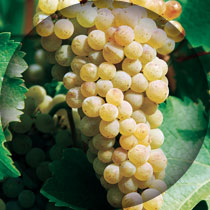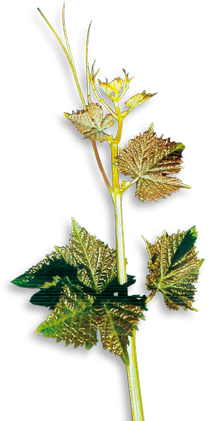Viosinho (PT)
Variety: white | Category II | Portugal


General Information
Viosinho


Origin: The literature reveals very little about this variety. Gyrão (1822) mentioned a variety called Véozinho Verdeal in the Douro. The Véozinho-Verdeal also appears in the grapevine variety tables of Ferreira Lapa (1874) and Vila Maior (1875), but with no description. Viala and Valmorel (1909) mentioned the variety in Trás-os-Montes and, for the first time with its current name, the Viosinho was mentioned by C. Pinto de Menezes (1900) as having originated in Sabrosa (Douro).
Chief areas of distribution: Douro.
Official synonym(s) (national and OIV): None.
Historic and regional synonyms: Véozinho-Verdeal.
Homonym(s): None.
Area under cultivation: 100 ha.
New plantings: Under 0.2%.
Trend: Hardly planted, but slight upward trend.
Varietal variability: Medium.
Availability of propagating material: RNSV polyclonal material, and certified clone Nº 53 JBP available.
Molecular Profile (OIV)
Regional Classification
Morphology
Phenology
Vegetative Potential
Viticultural Parameters
Oenology
Variety Characteristics
| VVMD5 | VVMD7 | VVMD27 | VrZag62 | VrZag79 | VVS2 | ||||||
| Allele1 | Allele2 | Allele1 | Allele2 | Allele1 | Allele2 | Allele1 | Allele2 | Allele1 | Allele2 | Allele1 | Allele2 |
| 232 | 232 | 235 | 239 | 185 | 189 | 186 | 188 | 243 | 245 | 135 | 153 |
DOC quality wine: Porto, Douro.
IPR quality wine: Planalto Mirandês.
Regional wine: Minho, Trás-os-Montes, Estremadura, Terras do Sado, Alentejano, Azores.
Young shoot (form of tip): Open, very sparse hairs, strong overall anthocyanin colouration.
Young leaf: Copper, with strong overall anthocyanin colouration and sparse erect hairs.
Young shoot: Red stripes on the dorsal side of nodes and internodes. Greenish on the ventral side. Anthocyanin colouration in buds. Medium tendrils.
Inflorescence (sex of flower): Hermaphrodite.
Mature leaf: Small, pentagonal, three to five lobes, dark green blade, regular profile, slightly rugose, medium blistering of upper side of blade, convex-concave teeth; open V-shaped petiolar sinus, open V-shaped upper lateral sinuses, strong anthocyanin colouration on main veins; hairs of medium density between veins on lower side of blade.
Bunch: Small size, medium density, partially lignified peduncle of medium length.
Berry: Small, uniform, elliptic, regular yellow green cross-section of epidermis, medium bloom on berry skin. Flesh colourless, soft and very juicy. Short peduncle, difficult to detach.
Time of bud burst: At the same time as the Fernão Pires.
Flowering: At the same time as the Fernão Pires
Berry (colour change): 4 days after the Fernão Pires.
Berry (harvest ripe): 2 days before the Fernão Pires.
Vigour of shoot growth: Medium.
Pruning weight:: 800 g/vine.
Shoot attitude (habit): Erect.
Length of internodes: Short and medium.
Shoot length: Medium.
Tendency to form lateral shoots: Low.
Rate of multiple bud bursts: Low.
Bud fertility index: Medium to high; 1 = 1.62; 2 = 1.76; 3 = 1.73 flowers per shoot.
Yield: Low with traditional material, although Rebello da Fonseca (1791) mentioned large yield and N.
Almeida (1990) acknowledged this virtue. With certified clonal material yield of 10 - 17 t/ha are achieved. RNSV statistical value: 2.94 kg/vine (Average of at least 40 clones in Palmela over 5 years).
Yield consistency: Consistent.
Crop uniformity: Uniform.
Winkler Index: 1,297 for a 14 t/ha yield (Montemor).
Sensitivity to abiotic factors: Robust variety.
Susceptibility to fungal diseases: Susceptible to Oidium and Botrytis, with moderate sensitivity to Peronospora.
Systemic viral infection prior to selection: v20% GLRaV-3, 20% GVA, <50% RSPV.
Susceptibility to Pests: Robust variety.
Bunch size: Small.
Bunch density: High. Short peduncle.
Berry skin: Medium.
Vineyard conduction system: Suited to all training systems.
Soil requirement: Dry, fertile, well drained soils.
Climatic requirements: Withstands heat, but also adapts to cool climates (such as the Azores).
Vine density: Adapts to all vine spacings.
Rootstock: Very compatible with traditional rootstock of low vigour.
Irrigation: Very well suited to irrigation.
Incidence of coulure/millerandage: Rare.
Spoilage of mature berries: Very few problems, because of its early ripening.
Risk of bird damage: Protection recommended.
Machine harvest suitability: Suitable, at lower temperatures.
Wine type: Quality wine, dessert wine.
Potential alcohol content: Very good (13 - 14% vol.). RNSV statistical values: 13.25% vol. (Average of at least 40 clones in Vila Real over 5 years).
Natural acidity of must: Medium to low. RNSV statistical value: 4.67 g/l (Average of at least 40 clones in Vila Real over 5 years).
Risk of oxidation of must: Low.
Colour intensity of wine: Citrine.
Risk of oxidation of wine: Low.
Aromatic profile: Medium level of free terpenoids (as analysed in the Douro in 2003): 3.7 μg/l linalool; 6.9 μg/l α-Terpineol; 4.1 μg/l citronellol; 4.5 μg/l nerol; 4.1 μg/l geranol. Sensorially confirmed by a good number of floral aromas.
Ageing Potential: Very good.
Blending recommendation: Cerceal Branco, Síria.
Wine Descriptors: Good aromatic intensity, typically evocative of the scent of chamomile and plums which creates a fruity bouquet of some complexity. In the mouth, it presents itself as well rounded, with medium acid. It is full-bodied, with a lasting aroma. After the finish, the low acid detracts slightly from the overall good impression (N. Almeida).
Wine quality: Very high. This variety adapts very well to a range of climates and geographic locations (Alentejo, Azores), and is well-poised to play a greater role in future in the national range of grapevine varieties.
Variety Characteristics: Ampelographically, the leaves and bunch are very similar to the French Sauvignon Blanc. This variety has good yields, ripens early, and is geographically very adaptable. Its wine is of high quality with a floral bouquet, making it an excellent choice not only as a blending partner but also as a varietal.

